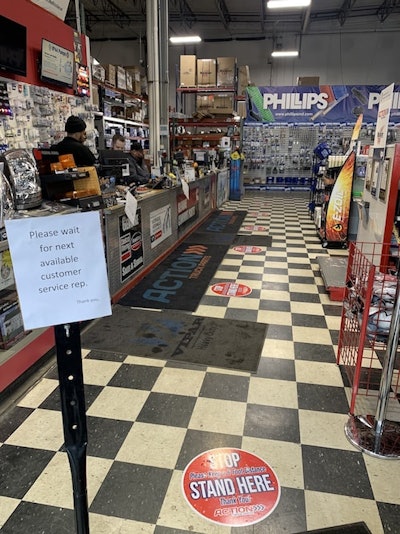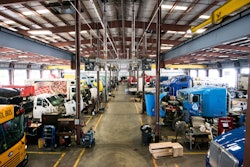
Effectively managing a parts inventory is a tough task in the best of times. Resources exist to help warehouse distributors analyze turn rates and regularly alter parts procurement, while many of the distribution channel’s strongest businesses are led by some of the sharpest and most experienced professionals in the industry.
But years of experience and a multitude of resources are no match for a global pandemic. With every supply chain on earth now ripe for (and likely to experience) disruption, parts distributors across trucking are assessing and rebuilding their procurement plans each day, working tirelessly to find the right strategy to keep their warehouses full and customers rolling.
Clickhere to view our full coverage of the coronavirus' impact on the trucking industry from the leading industry publications of Commercial Carrier Journal, Overdrive, Truckers News and Trucks, Parts, Service.
“We started looking at our inventory when the virus was really growing in China,” says Greg Klein, president, Inland Truck Parts (ITP). “When we saw they were shutting areas down we knew there would be a dwindling of certain parts down the line. We wanted to prepare for that.”
Rush Truck Centers took similar precautions in the early stages of the pandemic, increasing parts inventories throughout its dealer network to support an extra 30 days of demand in case of any temporary supplier-related warehouse or logistics stoppages. Thus far, the company says it has been fortunate, “With only a few minor exceptions, our supply chain has remained uninterrupted.”
That said, stability now doesn’t ensure stability later. Klein says ITP’s decision to increase its inventory wasn’t to address any immediate concern — such as the unnecessary run on toilet paper across the country — but to raise inventory to levels that could withstand parts shortages down the line.
Suppliers acknowledge a pinch on inventory is possible though they are doing everything possible to avoid one.
“Most manufacturing and assembly lines weren’t really designed for social distancing,” says Hendrickson Director of Aftermarket David McCleave. “We’re trying to adhere to new policies to spread people out and keep people safe … We know any interruption would have an impact down the line.”
Yet distributors also are aware the challenges they face due to the pandemic run deeper than parts availability. Even before COVID-19 reached North America, projections for aftermarket sales growth in 2020 were mostly flat. Equipment sales have been down for more than a year, freight rates are long removed from their 2018 peaks and prices in the energy sector have plummeted.
Action Truck Parts spent the first month of the year reorganizing and streamlining inventory across its three locations to account for market conditions, says Vice President Nick Seidel. The efficiency improvements were paying off before coronavirus upended everything, he says, and has now forced the distributor to course correct again to account for parts availability and customer activity. The latter is important to understand, Seidel says, because not every end user hauls “essential goods.” Many carriers are losing loads and parking trucks due to the pandemic.
 Floor signage is helping keep customers safe at Action Truck Parts.
Floor signage is helping keep customers safe at Action Truck Parts.“I do not want to have our inventory levels rise and then have a slowdown in customer purchases, leaving us with excess inventory and our turns drop because of a sales decrease,” he says. “We are watching the inventory very closely at this time.”
There’s also the fundamental issue of getting parts to customers. Action Truck Parts’ stores feature well stocked retail areas carefully designed to encourage shopping and promote product availability. Seidel says the company has been forced to restrict such shopping during the pandemic, limiting the number of customers in the store and placing signage on the ground to ensure customers stay a safe distance from one another.
Contactless or touchless pickup and delivery also have quickly made their way into the distribution vocabulary.
At TEC Equipment on the west coast, Strategic Initiatives Director Grant Small says the dealer group is receiving and fulfilling customer orders outside its facility to keep its buildings clean and employees as safe as possible.
 Sadler Power Train has placed barriers in front of its parts counter to maintain safe social distances between employees and customers.
Sadler Power Train has placed barriers in front of its parts counter to maintain safe social distances between employees and customers.In the Midwest, Sadler Power Train has initiated contact-free delivery, where the company’s drivers alert a customer when they’ve arrived, drop their order at their door and then send an image of the delivered goods and an invoice to the customer via email or text so no person-to-person interaction is required.
Keeping employees a safe distance from one another has become a sudden priority as well. Parts cannot be stocked and delivered to customers if a distribution business becomes contaminated with COVID-19 and is forced to shut down. Parts and service businesses are considered essential operations under Federal CISA guidelines — so long as they remain safe for their workers.
Rush Truck Centers has introduced a new corporate policy requiring employees to “do everything possible to stay more than six feet away from everyone else at all times. This includes not walking through hallways if another person is passing, not lining up at vending machines, copiers or counters without six feet of distance, not riding in cars with other employees and not sitting within six feet of each other in common areas.”
Distributors also are providing masks, disinfectant and sanitizing equipment and requiring workers to clean their workspaces as much as possible any time they come in contact with another person.
“You hate to say you’re reacting to this but everything is so new to us and the country that’s really all we can do right now,” says Dave Stastny, human resources director, Sadler Power Train. “We’re trying to learn as much as we can and look for solutions. When we find something that fits our needs we are trying to implement it.”











